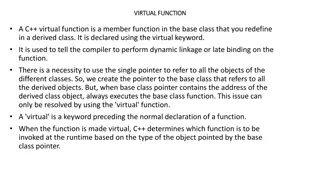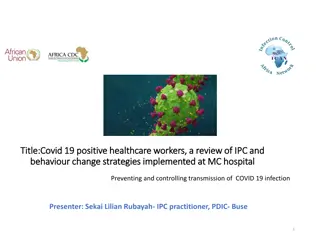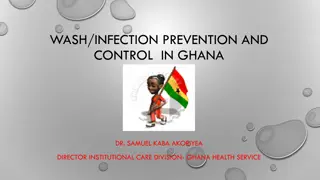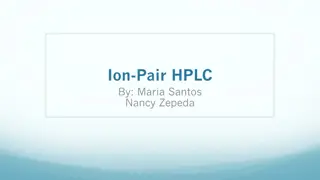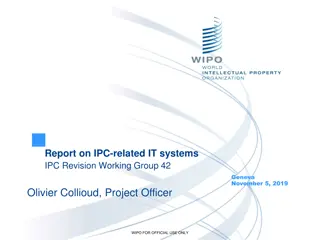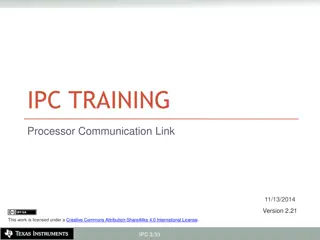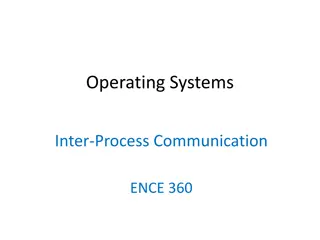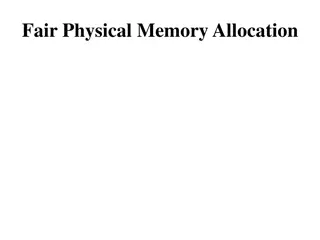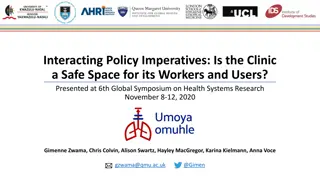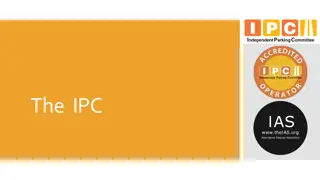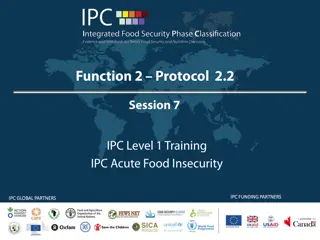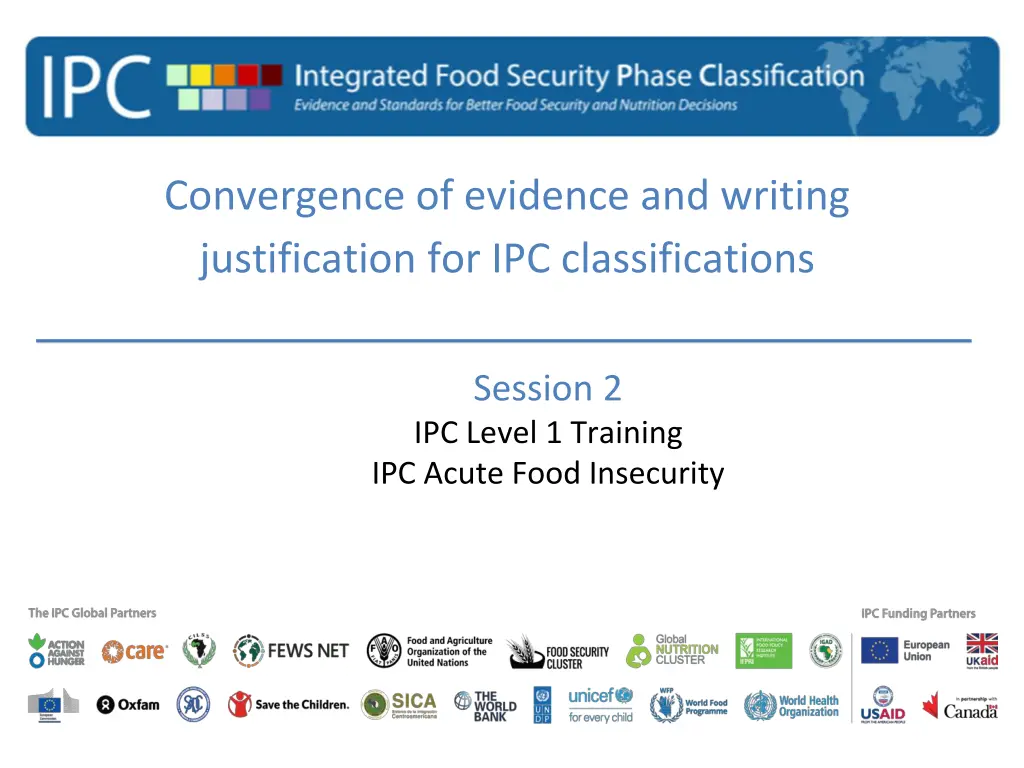
Writing Justification for IPC Classifications: Convergence of Evidence
Learn about the importance of convergence of evidence in IPC classifications for assessing acute food insecurity. Key points include analyzing relevant evidence, justifying conclusions, and handling non-converging evidence effectively. Explore examples and guidelines for accurate population estimations and classification criteria.
Download Presentation

Please find below an Image/Link to download the presentation.
The content on the website is provided AS IS for your information and personal use only. It may not be sold, licensed, or shared on other websites without obtaining consent from the author. If you encounter any issues during the download, it is possible that the publisher has removed the file from their server.
You are allowed to download the files provided on this website for personal or commercial use, subject to the condition that they are used lawfully. All files are the property of their respective owners.
The content on the website is provided AS IS for your information and personal use only. It may not be sold, licensed, or shared on other websites without obtaining consent from the author.
E N D
Presentation Transcript
Convergence of evidence and writing justification for IPC classifications Session 2 IPC Level 1 Training IPC Acute Food Insecurity
d) Convergence of evidence IPC brings together evidence on indicators directly measuring food security outcomes as well as contributing factors to estimate the proportion of households in each Phase. Key points: The whole body should be brought together for analysis - but only relevant evidence of a minimum reliability should be used for classification and estimation of populations; Evidence on malnutrition and mortality are only considered to the extent that they are driven by food gaps and to confirm or question food insecurity classification; In order to be considered, livelihood change outcome must be caused by negative changes in food security dimensions, esp. regarding access to food; It is important to provide a justification for the convergence of evidence conclusions reached by the analysts, referring to body of evidence used
d) Convergence of evidence (cont.) Key points (cont.): Evidence does not always converge especially because: Context matters Relevance as indicators measure different things Reliability, both in terms of methods and time relevance of evidence ? Non-converging evidence should be carefully assessed by considering these factors, and outliers may be given less importance For estimation of the populations it is advisable: To convergence evidence by consensus building and critical review of evidence supported by the Reference Table and Analytical Framework - not by average, modelling, or individual indicators. Not to use ranges for final population estimations although ranges may be useful to support estimation of populations for outcomes. Use of rounding is advisable and percentages may be rounded to nearest 0 or 5% and populations for example to nearest thousand.
d) Convergence of evidence (example) Example table on food consumption indicators for Convergence of Evidence: Background Sindh/Pakistan suffers from severe drought that has caused a spike in food insecurity No convergence of indicators: data indicates a potential food gap through FCS and rCSI, but households still have at least some food to consume as HHS is low. It is likely that even if not all of the 40% of HHs have high food consumption gaps as expected in a Phase 4 situation and as FCS and rCSI indicate, it is probable that many of them do. Analysts do not follow one or another extreme value, but aim for the middle ground
e) 20% rule for area classification An area is classified in a specific IPC Phase when at least 20 percent of the population in the area are experiencing the conditions related to that Phase or more severe Phases Key points: Phase classification intrinsically linked to population estimates Recommended to cross-check final classification with Phase description to see if conditions on the ground match the identified Phase (and population estimates) Phase 1 Phase 2 Phase 3 Phase 4 Phase 5 Area Phase Examples 20% 30% 35% 15% 0% Phase 1 Phase 2 Phase 3 Phase 4 Phase 5 Area Phase 45% 40% 10% 5% 0%
i) Current classifications Current Classifications are based on actual conditions, regardless of causes, context and duration. Key points: Just as a thermometer measures the exact temperature felt at the moment it is dipped in hot water, IPC classifies exactly what it sees at that moment in time this being the product of all [mitigating and aggravating] factors Current population tables identify those currently found in different severity Phases An understanding of the potential role of humanitarian assistance in mitigating the severity of acute food insecurity is necessary
i) Current classifications (cont.) For example For example The following table should have a disclaimer The following table should have a disclaimer Current Number of People by Phase (regardless of potential provision of humanitarian assistance) Current population table refers to those currently found in different severity Phases. The population of 14,500 people in Phase 3 or more severe does not necessarily reflect the full population in need of urgent action to decrease food gaps and protect and save lives and livelihoods. This is because some households may be in Phases 1 or 2 but only because of receipt of assistance, and as a result they may be in need of continued action. IPC does not quantify the impact of assistance and as a result alternative population figures discounting the effects of assistance are not provided.
Current Classifications Step 4: Determine area classification and population estimates Relevance: To provide a critical review of supporting and contradictory evidence used to arrive at Phase classification and estimation of number and percentage of people in different Phases Approach Overview: Distribute the proportion of households in each Phase Conclude on area classification Provide conclusion for final classification Assign evidence level of classification 8
Current Classifications Step 4: Area classification & pop. estimates Distribute the proportion of households in each Phase Some good practices Some good examples Review all evidence in a cheat- sheet The whole body of evidence should be brought together for classification Take into account special considerations for convergence of evidence Although outcomes are more useful to estimate populations, inference from contributing factors and trend analysis are of special value. Analysis of specific household groups also supports population estimations Evidence does not always converge indicator, context and reliability should be considered (outliers should be reviewed) Both supporting and contradictory evidence should be assessed To be completed by the Analysis Team during workshop 9
Current Classifications Step 4: Area classification & pop. estimates Write a well articulated conclusion statement Conclude on Area Classification Use 20% Rule Summary key supporting and contradictory evidence into a short paragraph. Rule to be used on population estimations based on food consumption and livelihood change contributing factors and outcomes As much as possible, the conclusion should also mention which household groups are the most affected. Analysis Acute Malnutrition and Mortality Assess how acute malnutrition and mortality support/contradict classification To be completed by the Analysis Team during workshop 10
Current Classifications Step 4: Area classification & pop. estimates Food dimensions Key drivers Example of a well articulated conclusion statement Aruna has been classified in Phase 3 Crisis for the April July period. The key drivers of the situation are prolonged dry season and low purchasing power of the population due to high reliance on subsistence agriculture as the main livelihood. Due to the prolonged dry season estimated 40% of households have run out of their food stocks and are now using unsustainable livelihood coping mechanisms, such as sale of productive assets in order to afford to buy food at prices that are 50% higher than usual at this time of the year. 35% of households are using food coping (rCSI >19) and 48% have borderline or poor Food Consumption Score. The most affected are those with small plots who have already run of stocks, and casual labourers who are totally dependent on market for their food needs. Most affected household groups Outcomes To be completed by the Analysis Team during workshop 11
www.IPCinfo.org The End

